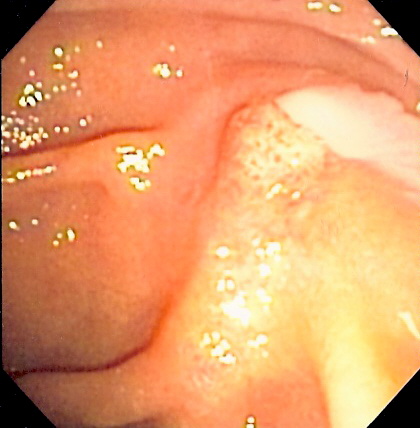Ascending cholangitis: Difference between revisions
Jump to navigation
Jump to search
No edit summary |
|||
| (30 intermediate revisions by 5 users not shown) | |||
| Line 1: | Line 1: | ||
__NOTOC__ | |||
{{Infobox_Disease | | {{Infobox_Disease | | ||
Name = Ascending cholangitis | | Name = Ascending cholangitis | | ||
| Line 11: | Line 10: | ||
OMIM = | | OMIM = | | ||
MedlinePlus = | | MedlinePlus = | | ||
MeshName = | | MeshName = | | ||
MeshNumber = | | MeshNumber = | | ||
}} | }} | ||
{{ | {{Ascending cholangitis}} | ||
'''For patient information click [[{{PAGENAME}} (patient information)|here]]''' | |||
{{CMG}}; {{AE}} {{AHS}},''' [[User: Prashanthsaddala|Prashanth Saddala M.B.B.S]] | |||
{{ | {{SK}} Acute cholangitis; bile duct inflammation | ||
==[[Ascending cholangitis overview|Overview]]== | |||
==[[Ascending cholangitis pathophysiology|Pathophysiology]]== | |||
==[[Ascending cholangitis causes|Causes]]== | |||
== | ==[[Ascending cholangitis differential diagnosis|Differentiating Ascending cholangitis from other Diseases]]== | ||
== | ==[[Ascending cholangitis epidemiology and demographics|Epidemiology and Demographics]]== | ||
== | ==[[Ascending cholangitis risk factors|Risk Factors]]== | ||
==[[Ascending cholangitis natural history|Natural History, Complications and Prognosis]]== | |||
==Diagnosis== | ==Diagnosis== | ||
[[Ascending cholangitis history and symptoms|History and Symptoms]] | [[Ascending cholangitis physical examination|Physical Examination]] | [[Ascending cholangitis laboratory findings|Laboratory Findings]] | [[Ascending cholangitis x ray|X Ray]] | [[Ascending cholangitis CT|CT]] | [[Ascending cholangitis MRI|MRI]] | [[Ascending cholangitis ultrasound|Ultrasound]] | [[Ascending cholangitis other imaging findings|Other Imaging Findings]] | [[Ascending cholangitis other diagnostic studies|Other Diagnostic Studies]] | |||
| | |||
| | |||
| | |||
| | |||
| | |||
| | |||
==Treatment== | ==Treatment== | ||
[[Ascending cholangitis medical therapy|Medical Therapy]] | [[Ascending cholangitis surgery|Surgery]] | [[Ascending cholangitis primary prevention|Primary Prevention]] | [[Ascending cholangitis cost-effectiveness of therapy|Cost-Effectiveness of Therapy]] | [[Ascending cholangitis future or investigational therapies|Future or Investigational Therapies]] | |||
==Case Studies== | |||
:[[Ascending cholangitis case study one|Case #1]] | |||
{{Gastroenterology}} | {{Gastroenterology}} | ||
[[Category:Gastroenterology]] | [[Category:Gastroenterology]] | ||
[[Category:Inflammations]] | [[Category:Inflammations]] | ||
[[Category:Disease]] | |||
{{WikiDoc Help Menu}} | {{WikiDoc Help Menu}} | ||
{{WikiDoc Sources}} | {{WikiDoc Sources}} | ||
<references /> | |||
Latest revision as of 18:27, 9 October 2018
| Ascending cholangitis | |
 | |
|---|---|
| Duodenoscopy image of pus extruding from Ampulla of Vater, indicative of cholangitis | |
| ICD-10 | K83.9 |
| ICD-9 | 576.1 |
|
Ascending cholangitis Microchapters |
|
Diagnosis |
|---|
|
Treatment |
|
Case Studies |
|
Ascending cholangitis On the Web |
|
American Roentgen Ray Society Images of Ascending cholangitis |
For patient information click here
Editor-In-Chief: C. Michael Gibson, M.S., M.D. [1]; Associate Editor(s)-in-Chief: Anila Hussain, MD [2], Prashanth Saddala M.B.B.S
Synonyms and keywords: Acute cholangitis; bile duct inflammation
Overview
Pathophysiology
Causes
Differentiating Ascending cholangitis from other Diseases
Epidemiology and Demographics
Risk Factors
Natural History, Complications and Prognosis
Diagnosis
History and Symptoms | Physical Examination | Laboratory Findings | X Ray | CT | MRI | Ultrasound | Other Imaging Findings | Other Diagnostic Studies
Treatment
Medical Therapy | Surgery | Primary Prevention | Cost-Effectiveness of Therapy | Future or Investigational Therapies